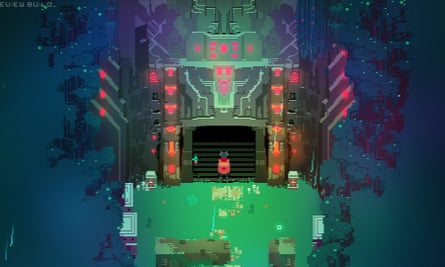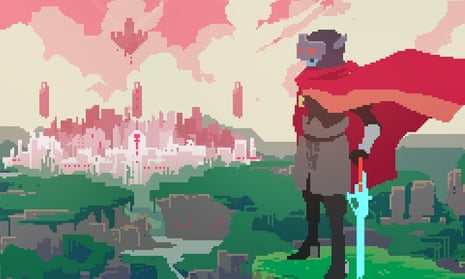Hyper Light Drifter is a game about struggle. Released in March to wide critical acclaim, it opens with a wordless three-minute animation in which an unknown land is ravaged by a blinding explosion; a lake of blood forms and quickly fills with the corpses of alien creatures. It looks like a standard science-fiction tale of doomed planets and extraterrestrial invasion, but it turns out these scenes of massacre are the visions of a single person, the titular drifter.
Put in the eight or so hours to beat Hyper Light Drifter and it’s likely you won’t learn much more about its mysterious world. Ostensibly an action role-playing game, it borrows the best parts of classic titles such as The Legend of Zelda: A Link to the Past and Diablo, to produce something that looks like a classic 1990s console adventure. You dash through lush woods and crystal lagoons, and you fight poison wolves and old knights with an electric blue sword and a modifiable gun. Yet not much is told of the world along the way save the occasional slideshow of images that stand-in for the spoken words of the frightened locals.

It’s a game that shows rather than tells, and it expects you to pay attention to its every detail to piece it all together. But everything you need to know about the game’s underlying story is there in that opening animation, which recurs like a nightmare throughout the journey. In it, you see the drifter coughing up bright pink blood, bent over in pain as their insides rip apart. Right after that, the character is shown entering a colossal fight with a large, relentless monster made of black ooze, which eventually engulfs the drifter in a dark webby prison.
This is all metaphor – and it is about the game’s developer Alex Preston. “I’ve dealt with serious health issues since I was born: congenital heart disease, to start,” he says. “A plethora of digestive and immune system problems have left me hospitalised on numerous occasions, often near death. This gives me a certain perspective on life, and plays into the stories I want to tell.
“The main character in Hyper Light Drifter suffers from a deadly illness, one he is desperately seeking a cure for. It haunts him, endlessly. That’s something I’m keenly familiar with.”
Hyper Light Drifter isn’t the first time that Preston has channelled his fluctuating health – and the proximity of death – into art. He explored the subject during college in the form of painting and film, experimenting with both abstract and hyper-real styles. “I made a lot of unsatisfying, straight-up bad work,” he says. “I think most [art students] should. I threw stuff at the walls to see what stuck, what resonated with me and my peers. It was incredibly helpful to make some trashy work that I eventually burned or gave away, as it made me a better artist, brought me closer to defining what I actually wanted to say with any of my work moving forward.”
Preston underwent gruelling open heart surgery as a baby and had a pacemaker installed a few years ago. The sense of physical fragility has been with him his whole life. “I see my cardiologist every six months, as well as another for my cholesterol and pacemaker checkups,” he says. “I just had a heart valve installed in November of 2015. I still struggle daily with diet, medications, trying to feel less like horrible garbage so I can get up and work on something.”
“My life will never be normal, I doubt my health will get much better – there will always be problems, and I suspect this state of generally feeling bad is sticking around for some time. But I currently have enough support through family, friends, people I care about and my work that I can deal with the struggle. This month, at least.”
It’s his reliance on machines and skilled doctors that led to the name of Preston’s studio, Heart Machine. It’s the name under which Preston intends to make his most ambitious and personal projects. “The biggest component here is my ability to tell a story I can identify with, expressing something personal to a larger audience, so I feel more connected and have an outlet for the many emotions that crop up around life-altering issues,” Preston says. This was the dream he had in mind when putting Hyper Light Drifter, the studio’s debut, on Kickstarter back in September 2013. A month later and his game had raised $645,159 in funding, far beyond the $27,000 Preston was initially looking for to make the full game.
The original plan was to have Hyper Light Drifter finished and released in 2014. However, the opportunity provided by the success of the crowdfunding campaign meant Preston was able to expand the scope of the project. He also suffered from health problems at the time, meaning that certain development goals had to be delayed. The combination pushed the game’s release date back to 2016.
Fortunately, while making Hyper Light Drifter was at times tough, Preston had plenty of support from those close to him in Los Angeles. Most importantly, he was able to move out away from making the game in his home by founding a community space known as Glitch City with some of his friends.
He says: “A small group of us were all tired of working in our bedrooms or living rooms or garages, and knew we had a lot of common knowledge and enjoyed each other’s company, so why not find a place we could all work together?
“No longer lonely, we can consult one another, provide support in many ways and build a larger community to host positive events and foster other work we’re fascinated by.”
This article includes content provided by Instagram. We ask for your permission before anything is loaded, as they may be using cookies and other technologies. To view this content, click 'Allow and continue'.
Glitch City comprises around 1,000 sq ft of office space in Culver City, California, typically hosting 10 people at a time, though Preston says some days can become much busier. Over the past couple of years he worked there with the small team he put together for Hyper Light Drifter, which includes coders and designers Beau Blyth, who previously made popular local multiplayer game Samurai Gunn, as well as Teddy Diefenbach.
Other regulars there include Ben Esposito (creator of Donut County), Brendon Chung (known for the award-winning Thirty Flights of Loving), and Ben Vance (creator of the virtual reality game Irrational Exuberance). There are also a number of “developer friends” who drift in and out of the space as they wish. Preston is particularly fond of the show-and-tell session that is held at the end of each week for people to recap their work and open it up to others.
Preston says being a part of Glitch City helped greatly with inspiration and motivation while toiling away on Hyper Light Drifter. “We can ask for advice from one another, ask for play testing, thoughts, have long conversations about detailed design topics,” he says. “But because it’s not a conventional office environment, it’s also possible to just not turn up when solitude is needed. Sometimes you want to hide in a dark cave alone and work, shut everyone else out. There are, ups and downs, like any situation.”

It’s not only the people who were physically close to Preston that helped him push through those harder days. While making Hyper Light Drifter he publicly shared some of his health struggles, which led to him receiving a number of letters from anticipating fans with similar issues. “It’s been one of the most incredible aspects of this whole process,” he says. “To have people willing to share such intense experiences with a stranger – one they have found enough common ground with to find the courage to do so – is stunning. It reminds me to take a moment outside of my own struggles. It’s also deeply inspiring for me to know that I’ve had any kind of meaningful impact or effect on people. I can’t ask for much more.”
Over time, with these messages of support from people all around the world, Hyper Light Drifter’s story shifted from being about the struggle of one person to the similar struggles of many. The game itself upholds this through its ambiguity; by avoiding words and a clearly defined narrative, people are able to project their own experiences with illness and pain onto it. It is a canvas for these people and one that encourages them to bite down and overcome their struggles, just as the drifter does.
“I’m fairly satisfied,” Preston says reflecting on the finished game. “There’s always more you want to do; more polish, more content, more ideas that never make it into a work with this scope and scale. The story, the underlying messages, for those that care to dig and observe a bit, I feel communicates what I had wanted. People identify with it; they feel an attachment.”
Hyper Light Drifter is only the beginning of a larger endeavour for Preston. For him, the success he’s achieved in creating a game so personal yet far-reaching is part of a struggle that continues beyond the game. He can’t just turn it off. “I have a deep need to keep funnelling my personal nightmares and frustrations into my work,” he says. “It keeps me functioning. I don’t think I can avoid it.”

Comments (…)
Sign in or create your Guardian account to join the discussion